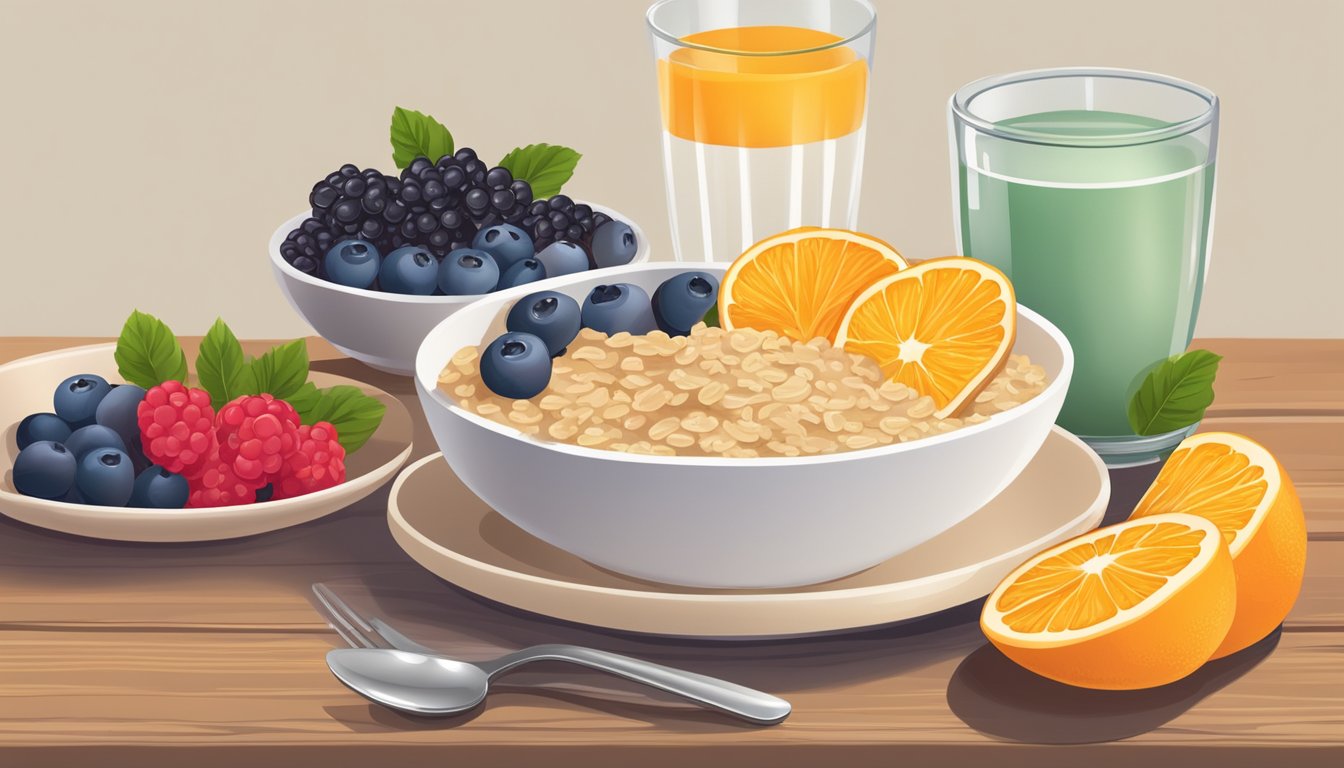Starting your day with a fiber-rich breakfast sets the tone for healthy eating habits. Many common breakfast foods contain significant amounts of dietary fiber, providing numerous health benefits. Oatmeal, whole grain cereals, fruits, and vegetables are excellent sources of fiber that can easily be incorporated into your morning meal.
Fiber plays a crucial role in digestive health, blood sugar regulation, and maintaining a feeling of fullness. While only a small percentage of adults in the United States meet their daily fiber goals, focusing on fiber-rich breakfast options can help bridge this nutritional gap. From avocado toast on whole grain bread to high-fiber breakfast smoothies, there are countless delicious ways to boost your fiber intake first thing in the morning.
Exploring a variety of fiber-rich breakfast foods not only supports digestive health but also adds diversity to your diet. Options like chia seed pudding, bran muffins, and breakfast burritos with beans offer both soluble and insoluble fiber. By choosing these nutritious breakfast alternatives, you can take a significant step towards meeting your daily fiber requirements and improving overall health.
Understanding the Importance of Fiber
Fiber plays a crucial role in maintaining overall health and wellness. It supports digestive function, helps regulate blood sugar, and contributes to heart health.
Health Benefits of Fiber
Fiber promotes digestive health by supporting regular bowel movements and maintaining a healthy gut microbiome. It aids in preventing constipation and reduces the risk of developing hemorrhoids. Fiber also helps lower cholesterol levels, which is beneficial for heart health.
Studies have shown that a high-fiber diet may reduce the risk of developing type 2 diabetes by helping to regulate blood sugar levels. This regulation occurs because fiber slows down the absorption of sugar in the bloodstream.
Consuming adequate fiber can contribute to weight management. High-fiber foods often require more chewing time and provide a feeling of fullness, which can help reduce overall calorie intake.
Recommended Fiber Intake
The Dietary Guidelines recommend that adults consume 25-30 grams of fiber daily. However, most people fall short of this target. Women should aim for at least 25 grams per day, while men should strive for 38 grams.
To increase fiber intake, focus on incorporating whole grains, fruits, vegetables, legumes, and nuts into meals. Start the day with a high-fiber breakfast, such as oatmeal topped with berries and nuts.
It’s important to increase fiber intake gradually and drink plenty of water. This approach helps prevent digestive discomfort that can occur when fiber is added too quickly to the diet.
Reading food labels can help track fiber intake. Look for products that provide at least 3 grams of fiber per serving to boost daily consumption.
Types of Fiber

Fiber comes in two main forms that offer distinct benefits for digestive health and overall wellbeing. Each type plays a unique role in the body and can be found in various breakfast foods.
Soluble Fiber
Soluble fiber dissolves in water, forming a gel-like substance in the digestive tract. This type of fiber helps slow digestion and promotes feelings of fullness. It aids in managing blood sugar levels and can help lower cholesterol.
Common breakfast foods high in soluble fiber include:
- Oatmeal
- Chia seeds
- Apples
- Berries
Soluble fiber acts as a prebiotic, feeding beneficial gut bacteria. This supports digestive health and may boost immune function. Adding chia seeds to breakfast cereal or oatmeal can significantly increase soluble fiber intake.
Insoluble Fiber
Insoluble fiber does not dissolve in water. It adds bulk to stool and helps food pass more quickly through the stomach and intestines. This type of fiber promotes regular bowel movements and prevents constipation.
Breakfast foods rich in insoluble fiber include:
- Whole grain breads and cereals
- Bran
- Nuts and seeds
- Fruit and vegetable skins
Insoluble fiber supports overall digestive health and may reduce the risk of certain types of cancer. Choosing whole grain toast or adding nuts to yogurt can boost insoluble fiber intake at breakfast.
High-Fiber Foods for Breakfast
Fiber-rich breakfast options provide numerous health benefits and help kickstart your day. These foods promote digestive health, aid in weight management, and contribute to overall well-being.
Fruits Rich in Fiber
Berries are excellent sources of fiber for breakfast. Raspberries contain 8 grams of fiber per cup, while blackberries and strawberries offer 7-8 grams. These fruits can be eaten alone or added to yogurt, cereal, or smoothies.
Bananas provide about 3 grams of fiber per medium-sized fruit. They’re easy to eat on-the-go and pair well with other breakfast foods.
Pears are another fiber-rich option, with 5-6 grams per medium fruit. They can be sliced and added to oatmeal or eaten whole.
Avocados offer both healthy fats and fiber. Half an avocado contains about 5 grams of fiber. It can be spread on toast or added to smoothies for a creamy texture.
Whole Grains and Cereals
Oats are a breakfast staple high in fiber. One cup of cooked oatmeal provides 4 grams of fiber. Steel-cut oats offer even more fiber than rolled oats.
Bran cereals are among the highest fiber breakfast options. Some varieties contain up to 14 grams of fiber per serving. They can be eaten with milk or used as a topping for yogurt.
Whole grain breads and English muffins are good choices for toast. Look for options with at least 3 grams of fiber per slice.
Quinoa can be used as a breakfast grain. It contains 5 grams of fiber per cooked cup and is also high in protein.
Seeds and Nuts
Chia seeds are fiber powerhouses. Just 1 ounce (about 2 tablespoons) provides 10 grams of fiber. They can be added to smoothies, oatmeal, or used to make chia pudding.
Flaxseeds offer 3 grams of fiber per tablespoon. Ground flaxseeds are easier for the body to digest and can be sprinkled on cereal or yogurt.
Almonds, walnuts, and pistachios are nuts high in fiber. A quarter-cup serving provides 3-4 grams. They make great toppings for oatmeal or yogurt.
Nut and seed butters, such as almond butter, peanut butter, and sunflower seed butter, offer 1-2 grams of fiber per tablespoon. They can be spread on toast or added to smoothies.
Legumes and Beans
Black beans and white beans can be incorporated into savory breakfast dishes. Half a cup of cooked beans provides 7-8 grams of fiber.
Lentils are versatile legumes that can be used in breakfast bowls or as a side dish. One cup of cooked lentils offers 15 grams of fiber.
Chickpeas can be roasted for a crunchy breakfast topping or mashed to make a spread. Half a cup provides 6 grams of fiber.
Soy products like tofu and tempeh can be used in breakfast scrambles. They offer 2-3 grams of fiber per half-cup serving.
High-Fiber Breakfast Ideas
Incorporating fiber-rich foods into your morning meal can kickstart your day with improved digestion and sustained energy. From quick grab-and-go options to leisurely sit-down feasts, there are numerous delicious ways to boost your fiber intake at breakfast.
Quick and Easy Options
For those busy mornings, high-fiber cereals offer a convenient solution. Many brands provide 12 grams or more of fiber per serving. Pair them with milk or yogurt for added protein. Whole grain toast topped with avocado and a sprinkle of chia seeds makes for a fast, fiber-packed meal.
Smoothies are another speedy choice. Blend fruits like berries and bananas with spinach, Greek yogurt, and a tablespoon of ground flaxseed for a nutritious on-the-go breakfast. For extra fiber, add a scoop of oats or a serving of high-fiber cereal to your smoothie.
Breakfast wraps using whole wheat tortillas filled with scrambled eggs, black beans, and vegetables offer a savory high-fiber option that’s easy to eat on the run.
Make-Ahead Breakfasts
Overnight oats are a popular make-ahead choice. Mix rolled oats with milk, yogurt, and your favorite toppings like berries, nuts, and seeds. Let it sit in the fridge overnight for a creamy, fiber-rich breakfast.
Chia pudding is another excellent prep-ahead option. Combine chia seeds with milk and sweetener, then refrigerate. In the morning, top with fresh fruit and a dollop of Greek yogurt for added protein and fiber.
Prepare a big batch of whole-grain pancakes or waffles on the weekend. Reheat them during the week and top with fresh fruit and a drizzle of maple syrup for a quick, fiber-filled breakfast.
Sit-Down Breakfast Meals
For a leisurely weekend breakfast, try shakshuka – eggs poached in a spicy tomato sauce. Serve it with whole grain bread for dipping. This Middle Eastern dish is not only delicious but also high in fiber.
Oatmeal is a classic high-fiber breakfast. Cook steel-cut oats and top with nuts, seeds, and fresh or dried fruits for added fiber and flavor. For a twist, try savory oatmeal with sautéed vegetables and a poached egg.
A breakfast salad might sound unconventional, but it’s a great way to pack in fiber. Mix leafy greens with roasted sweet potatoes, quinoa, and a soft-boiled egg. Dress with a light vinaigrette for a refreshing start to your day.
Plant-Based Selections
Plant-based options are naturally high in fiber. A tofu scramble with vegetables and whole grain toast provides a protein and fiber-rich vegan breakfast. Add some sliced avocado for healthy fats and extra fiber.
Smoothie bowls are both nutritious and Instagram-worthy. Blend frozen acai or mixed berries with plant-based milk and top with granola, fresh fruits, and a sprinkle of hemp seeds for a colorful, fiber-packed meal.
Try a plant-based breakfast burrito filled with seasoned black beans, brown rice, and plenty of veggies. Wrap it in a whole wheat tortilla for an extra fiber boost. Serve with salsa for added flavor and nutrition.
Incorporating Fiber into Your Diet
Adding fiber-rich foods to breakfast can boost overall intake. Pairing fiber with protein and healthy fats creates balanced, satisfying meals to start the day.
Balancing Fiber with Other Nutrients
Fiber works best when combined with other essential nutrients. Pair high-fiber foods with protein sources like eggs, Greek yogurt, or nut butter. This combination promotes satiety and helps regulate blood sugar levels.
Add antioxidant-rich berries to fiber-packed oatmeal. Top whole grain toast with avocado and a poached egg for healthy fats and protein. Mix quinoa into yogurt with nuts and seeds for a nutrient-dense meal.
Aim for 25-38 grams of fiber daily, spread across meals. A fiber-rich breakfast might provide 7-10 grams. Balance is key – don’t neglect other important nutrients while increasing fiber intake.
Adjusting Fiber Intake Gradually
Increase fiber consumption slowly to avoid digestive discomfort. Start by adding one new high-fiber food to your breakfast each week. This gradual approach allows your digestive system to adapt.
Drink plenty of water when boosting fiber intake. Fluids help fiber move through the digestive tract, promoting healthy bowel movements. Aim for at least 8 glasses of water daily.
Listen to your body as you increase fiber. Some may experience temporary bloating or gas. These effects typically subside as your system adjusts. If discomfort persists, consult a healthcare professional.
Cooking Tips for Fiber-Rich Meals
Prepare fiber-rich foods in ways that enhance flavor and texture. Soak oats overnight for a creamy texture. Toast nuts to bring out their natural oils and flavors. Roast vegetables to caramelize their natural sugars.
Experiment with different preparation methods. Try baked oatmeal, smoothie bowls, or breakfast grain bowls. These variations can make high-fiber meals more appealing and prevent boredom.
Batch cook fiber-rich foods for convenience. Prepare a large pot of steel-cut oats or quinoa at the start of the week. Store in individual portions for quick, nutritious breakfasts. Keep high-fiber snacks like fruit and nuts readily available for easy access.
Potential Considerations
Incorporating fiber-rich breakfast foods requires thoughtful planning. Individual health conditions and potential side effects should be taken into account when increasing fiber intake.
Managing Fiber Intake for Specific Health Conditions
Fiber consumption can impact various health conditions. For heart health, soluble fiber from oats and fruits can help lower cholesterol levels. Individuals with type 2 diabetes may benefit from fiber’s ability to slow sugar absorption and stabilize blood glucose.
Those with digestive issues should introduce fiber gradually. Certain conditions like Crohn’s disease may require a low-fiber diet. Consulting a healthcare provider is crucial for personalized recommendations.
Fiber can aid in managing constipation by promoting regular bowel movements. However, excessive intake may worsen symptoms for some individuals. Balancing fiber with adequate hydration is key for optimal digestive health.
Possible Side Effects
Rapidly increasing fiber intake can lead to temporary discomfort. Common side effects include bloating, gas, and abdominal cramping. These symptoms usually subside as the body adjusts to higher fiber levels.
Excessive fiber consumption may interfere with nutrient absorption. It can bind to minerals like iron and calcium, potentially reducing their bioavailability. This is particularly important for individuals with nutrient deficiencies or at risk of malnutrition.
Some high-fiber breakfast foods may contain added sugars or unhealthy fats. Reading nutrition labels is essential to ensure balanced choices. Whole food sources of fiber are generally preferable to processed fiber-enriched products.
Certain medications may interact with high-fiber diets. Fiber can affect the absorption of some drugs. Patients taking medications should discuss their fiber intake with a healthcare provider to avoid potential interactions.




